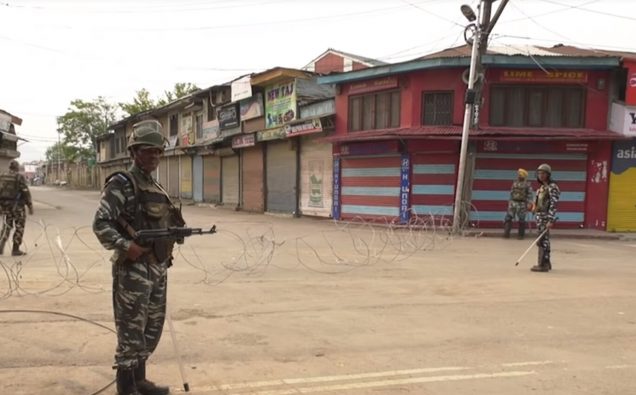
In a rare first-hand account by a Western journalist, an American magazine has revealed harrowing Indian state repression against the people of Kashmir, which since August 5 revocation of its autonomy has been virtually cut off from rest of the world.
The New Yorker article, written by Dexter Filkins, who went into the troubled region incognito and met with victims, tells readers about Indian Prime Minister’s Narendra Modi‘s virulent push to promote Hindu nationalism in India.
The exclusivist ideology of Hinduta seeks domination of the majority Hindu population and targets Muslims and other religious minorities, his illegal annexation of Jammu and Kashmir and the repressive lockdown of the disputed state.
“The change in Kashmir upended more than half a century of careful politics, but the Indian press reacted with nearly uniform approval,” Filkins, stunned by Indian media’s obedience, writes.
Filkins, a staff writer at the New Yorker, sneaked into the curfew-bound Kashmir along with an Indian journalist Rana Ayyub, whose book, “Gujarat Files,” about a massacre of Muslims in the Indian state of Gujarat, has made her a target of Hindu nationalists.
Disguised as a local, Filkins visited hospitals, met with people on the streets and inside their homes to get a sense of how the Kashmiris are coping with the unprecedented lockdown of their territory.
“Ever since Modi was first elected Prime Minister, in 2014, he has been recasting the story of India, from that of a secular democracy accommodating a uniquely diverse population to that of a Hindu nation that dominates its minorities, especially the country’s two hundred million Muslims,” Filkins says.
“Modi and his allies have squeezed, bullied, and smothered the press into endorsing what they call the ‘New India’,” he wrote, citing a number of instances about how much of the Indian media now supports the prime minister’s oppressive policies, ignoring his failures and covering up his lies, especially about the Balakot operation.
“Kashmiris greeted Modi’s decision with protests, claiming that his real goal was to inundate the state with Hindu settlers. After the initial tumult subsided, though, the Times of India and other major newspapers began claiming that a majority of Kashmiris quietly supported Modi—they were just too frightened of militants to say so aloud. Television reporters, newly arrived from Delhi, set up cameras on the picturesque shoreline of Dal Lake and dutifully repeated the government’s line,” said The New Yorker article, entitled “Blood and Soil in Narendra Modi’s India.”
Foreign journalists and observers are banned for entering occupied Kashmir despite repeated calls by the U.S. and international human rights bodies.
Filkins took the risk and dressed himself as an Indian and along with journalist Rana Ayyub flew into the Indian-administered Kashmir, which New Delhi now says is part of its union.
The two journalists dodged past the heavy Indian security at the Sirnagar airport and got into a taxi to the city two weeks after the August 5 crackdown.
The article also tells the story of a mother, whose son has been taken away by Indian forces and jailed. Indian forces have jailed thousands of children, some on the allegation that they pelted stones at security forces.
Here are some excerpts from the in-depth account, which speak about the Indian brutality and suffering of the Kashmiri people.
“Even from a moving car, it was clear that the reality in Kashmir veered starkly from the picture in the mainstream Indian press,” he wrote.
“Soldiers stood on every street corner. Machine-gun nests guarded intersections, and shops were shuttered on each block.
“Apart from the military presence, the streets were lifeless. At Khanqah-e-Moula, the city’s magnificent eighteenth-century mosque, Friday prayers were banned. Schools were closed. Cellphone and Internet service was cut off.
“Indian intelligence agents are widely understood to monitor the rosters of local hotels, so Ayyub and I, along with an Indian photographer named Avani Rai, had arranged to stay with a friend.
“When we got there, a Kashmiri doctor who was visiting the house told us to check the main hospital, where young men were being treated after security forces fired on them. The police and soldiers were using small-gauge shotguns—called pellet guns by the locals—and some of the victims had been blinded. ‘Go to the ophthalmology ward,’ the doctor said.
“At the hospital, we found a scene of barely restrained chaos, with security officers standing guard and families mixing with the sick in corridors. While I stood in a corner, trying to make myself inconspicuous, (Ms) Ayyub ran to the fourth floor to speak to an eye doctor. After a few minutes, she returned and motioned for me and Rai to follow. ‘Ward eight,’ she said. Thirty gunshot victims were inside.
“As the three of us approached, a smartly dressed man with a close-cropped beard stepped into our path and placed his hand on (Ms.) Ayyub’s shoulder. ‘What are you doing here?’ he said. Rai looked at me and quietly said, ‘Run.’ I turned and dashed into the crowd. The bearded man took (Ms.) Ayyub and Rai by the arm and led them away.
“When (Ms.) Ayyub and the photographer were detained at the hospital in Srinagar, I found a hiding place across the street, screened by a wall and a fruit vender; (Ms.) Ayyub would have faced serious repercussions if she was found to have snuck in a foreigner. After about an hour, they emerged. (Ms.) Ayyub said that an intelligence officer had questioned them intently, then released them with an admonition: ‘Don’t come back.’”

















